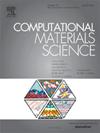Large exciton binding energy in atomically thin Cs3Bi2I9−xClx halide perovskite
IF 3.1
3区 材料科学
Q2 MATERIALS SCIENCE, MULTIDISCIPLINARY
引用次数: 0
Abstract
Two-dimensional lead-free perovskite CsBiI has emerged as a promising optoelectronic material due to its unique composition and quantum confinement effects. Herein, we present a comprehensive first-principles computational analysis of the many-body optoelectronic properties arising from the isoelectronic substitution of Cl into the I site in atomically thin CsBiICl. By solving the Bethe–Salpeter equation, we reveal the distinct optical properties of these doped and pristine monolayers, characterized by strongly bound excitons within an ultralow dielectric screening environment. Specifically, we demonstrate that the isoelectronic substitution of Cl in CsBiI enables significant tunability of quasiparticle states, leading to an unprecedented increase in the exciton binding energy from 1.32 eV to 2.66 eV, and a corresponding increase in the optical gap from the visible to the ultraviolet spectrum. The dominance of these strongly bound excitons in the ground-state properties highlights the substantial potential of these materials for high-efficiency optoelectronic applications, including light-emitting diodes, laser diodes, solar-blind photodetectors, and reconfigurable optical systems.

原子级薄Cs3Bi2I9−xClx卤化物钙钛矿中的大激子结合能
二维无铅钙钛矿Cs3Bi2I9由于其独特的组成和量子约束效应而成为一种很有前途的光电材料。在此,我们对原子薄的Cs3Bi2I9−xClx中Cl等电子取代到I位所引起的多体光电性质进行了全面的第一性原理计算分析。通过求解Bethe-Salpeter方程,我们揭示了这些掺杂和原始单层的独特光学性质,其特征是在超低介电屏蔽环境中具有强束缚激子。具体来说,我们证明了Cl在Cs3Bi2I9中的等电子取代使准粒子态具有显著的可调性,导致激子结合能从1.32 eV增加到2.66 eV,并相应地增加了从可见光到紫外光谱的光隙。这些强束缚激子在基态特性中的优势突出了这些材料在高效光电应用方面的巨大潜力,包括发光二极管、激光二极管、太阳盲光电探测器和可重构光学系统。
本文章由计算机程序翻译,如有差异,请以英文原文为准。
求助全文
约1分钟内获得全文
求助全文
来源期刊

Computational Materials Science
工程技术-材料科学:综合
CiteScore
6.50
自引率
6.10%
发文量
665
审稿时长
26 days
期刊介绍:
The goal of Computational Materials Science is to report on results that provide new or unique insights into, or significantly expand our understanding of, the properties of materials or phenomena associated with their design, synthesis, processing, characterization, and utilization. To be relevant to the journal, the results should be applied or applicable to specific material systems that are discussed within the submission.
 求助内容:
求助内容: 应助结果提醒方式:
应助结果提醒方式:


